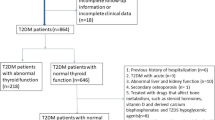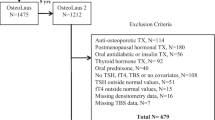Abstract
Introduction
Although it has been established that hyperthyroidism leads to reduced bone mineral density (BMD), with accelerated bone turnover promoting bone resorption in female patients, there is a dearth of data for male patients with hyperthyroidism. This study evaluated BMD and bone metabolism in male patients with Graves’ disease.
Methods
The study included 56 Japanese male patients with newly diagnosed Graves’ disease and 34 normal Japanese male control subjects of similar age and body mass index. We used dual energy x-ray absorptiometry to measure BMD at sites with different cortical/cancellous bone ratios (lumbar spine, femoral neck, and distal radius).
Results
At the lumbar spine and the distal radius, BMD and T-scores were significantly lower for patients than for controls. At the femoral neck, on the other hand, the same values were relatively, but not significantly, lower in patients than in controls. However, Z-scores at all three sites were significantly lower for patients than for controls. The Z -score at the distal radius of patients was significantly lower than that at their lumbar spine and femoral neck. In addition, Z-score at the distal radius correlated negatively with age, free thyroxine, thyroid stimulating hormone receptor antibodies, thyroid stimulating antibody, and urinary N-terminal telopeptide of type I collagen normalized by creatinine.
Conclusions
These results indicate a high prevalence of cortical bone loss in male patients with Graves’ disease, especially elderly patients. We conclude that BMD measurement is crucial in all Graves’ disease patients regardless of their gender and that the radial BMD as well as BMD at the lumbar spine and femoral neck should be monitored to effectively prevent bone loss and subsequent fracture.



Similar content being viewed by others
References
Campos-Pastor MM, Munoz-Torres M, Escobar-Jimenez F, Ruiz de Almodovar M, Jodar Gimeno E (1993) Bone mass in females with different thyroid disorders: influence of menopausal status. Bone Miner 21:1–8
Diamond T, Vine J, Smart R, Butler P (1994) Thyrotoxic bone disease in women: a potentially reversible disorder. Ann Intern Med 120:8–11
Gomez Acotto C, Schott AM, Hans D, Niepomniszcze H, Mautalen CA, Meunier PJ (1998) Hyperthyroidism influences ultrasound bone measurement on the Os calcis. Osteoporos Int 8:455–459
Olkawa M, Kushida K, Takahashi M, Ohishi T, Hoshino H, Suzuki M, Ogihara H, Ishigaki J, Inoue T (1999) Bone turnover and cortical bone mineral density in the distal radius in patients with hyperthyroidism being treated with antithyroid drugs for various periods of time. Clin Endocrinol (Oxf) 50:171–176
Mora S, Pitukcheewanont P, Kaufman FR, Nelson JC, Gilsanz V (1999) Biochemical markers of bone turnover and the volume and the density of bone in children at different stages of sexual development. J Bone Miner Res 14:1664–1671
Ben-Shlomo A, Hagag P, Evans S, Weiss M (2001) Early postmenopausal bone loss in hyperthyroidism. Maturitas 39:19–27
Karga H, Papapetrou PD, Korakovouni A, Papandroulaki F, Polymeris A, Pampouras G (2004) Bone mineral density in hyperthyroidism. Clin Endocrinol (Oxf) 61:466–472
Greenspan SL, Greenspan FS (1999) The effect of thyroid hormone on skeletal integrity. Ann Intern Med 130:750–758
Marcocci C, Golia F, Vignali E, Pinchera A (1997) Skeletal integrity in men chronically treated with suppressive doses of L-thyroxine. J Bone Miner Res 12:72–77
Rosen HN, Moses AC, Garber J, Ross DS, Lee SL, Ferguson L, Chen V, Lee K, Greenspan SL (1998) Randomized trial of pamidronate in patients with thyroid cancer: bone density is not reduced by suppressive doses of thyroxine, but is increased by cyclic intravenous pamidronate. J Clin Endocrinol Metab 83:2324–2330
Jodar E, Martinez-Diaz-Guerra G, Azriel S, Hawkins F (2001) Bone mineral density in male patients with L-thyroxine suppressive therapy and Graves disease. Calcif Tissue Int 69:84–87
Riggs BL, Melton LJ 3rd (1986) Involutional osteoporosis. N Engl J Med 26:1676–1686
Mosekilde L, Eriksen EF, Charles P (1990) Effects of thyroid hormones on bone and mineral metabolism. Endocrinol Metab Clin North Am 19:35–63
Lee MS, Kim SY, Lee MC, Cho BY, Lee HK, Koh CS, Min HK (1990) Negative correlation between the change in bone mineral density and serum osteocalcin in patients with hyperthyroidism. J Clin Endocrinol Metab 70:766–770
Wakasugi M, Wakao R, Tawata M, Gan N, Koizumi K, Onaya T (1993) Bone mineral density in patients with hyperthyroidism measured by dual energy X-ray absorptiometry. Clin Endocrinol (Oxf) 38:283–286
Jodar E, Munoz-Torres M, Escobar-Jimenez F, Quesada-Charneco M, Lund del Castillo JD (1997) Bone loss in hyperthyroid patients and in former hyperthyroid patients controlled on medical therapy: influence of aetiology and menopause. Clin Endocrinol (Oxf) 47:279–285
Mudde AH, Reijnders FJ, Kruseman AC (1992) Peripheral bone density in women with untreated multinodular goitre. Clin Endocrinol (Oxf) 37:35–39
Fraser SA, Anderson JB, Smith DA, Wilson GM (1971) Osteoporosis and fractures following thyrotoxicosis. Lancet 1:981–983
Kumeda Y, Inaba M, Tahara H, Kurioka Y, Ishikawa T, Morii H, Nishizawa Y (2000) Persistent increase in bone turnover in Graves’ patients with subclinical hyperthyroidism. J Clin Endocrinol Metab 85:4157–4161
Siddiqi A, Burrin JM, Noonan K, James I, Wood DF, Price CP, Monson JP (1997) A longitudinal study of markers of bone turnover in Graves’ disease and their value in predicting bone mineral density. J Clin Endocrinol Metab 82:753–759
Lucidarme N, Ruiz JC, Czernichow P, Leger J (2000) Reduced bone mineral density at diagnosis and bone mineral recovery during treatment in children with Graves’ disease. J Pediatr 137:56–62
Ugur-Altun B, Altun A, Arikan E, Guldiken S, Tugrul A (2003) Relationships existing between the serum cytokine levels and bone mineral density in women in the premenopausal period affected by Graves’ disease with subclinical hyperthyroidism. Endocr Res 29:389–398
Fittipaldi MR, Fonderico F, Vitale G, Ciccarelli A, Lupoli GA, Cascella T, Panico A, Lupoli G (2002) Osteoporosis treatment in elderly hyperthyroid male patients. J Endocrinol Invest 25:98–100
Toh SH, Claunch BC, Brown PH (1985) Effect of hyperthyroidism and its treatment on bone mineral content. Arch Intern Med 145:883–886
Bilezikian JP (1999) Osteoporosis in men. J Clin Endocrinol Metab 84:3431–3434
Milne M, Kang MI, Quail JM, Baran DT (1998) Thyroid hormone excess increases insulin-like growth factor I transcripts in bone marrow cell cultures: divergent effects on vertebral and femoral cell cultures. Endocrinology 139:2527–2534
Vestergaard P, Rejnmark L, Weeke J, Mosekilde L (2000) Fracture risk in patients treated for hyperthyroidism. Thyroid 10:341–348
Vestergaard P, Mosekilde L (2002) Fractures in patients with hyperthyroidism and hypothyroidism: a nationwide follow-up study in 16,249 patients. Thyroid 12:411–419
Vestergaard P, Mosekilde L (2003) Hyperthyroidism, bone mineral, and fracture risk-a meta-analysis. Thyroid 13:585–593
Cummings SR, Nevitt MC, Browner WS, Stone K, Fox KM, Ensrud KE, Cauley J, Black D, Vogt TM (1995) Risk factors for hip fracture in white women. Study of Osteoporotic Fractures Research Group. N Engl J Med 332:767–773
Wejda B, Hintze G, Katschinski B, Olbricht T, Benker G (1995) Hip fractures and the thyroid: a case-control study. J Intern Med 237:241–247
Abe E, Marians RC, Yu W, Wu XB, Ando T, Li Y, Iqbal J, Eldeiry L, Rajendren G, Blair HC, Davies TF, Zaidi M (2003) TSH is a negative regulator of skeletal remodeling. Cell 115:151–162
Morimura T, Tsunekawa K, Kasahara T, Seki K, Ogiwara T, Mori M, Murakami M (2005) Expression of type 2 iodothyronine deiodinase in human osteoblast is stimulated by thyrotropin. Endocrinology 146:2077–2084
Greenspan SL, Greenspan FS, Resnick NM, Block JE, Friedlander AL, Genant HK (1991) Skeletal integrity in premenopausal and postmenopausal women receiving long-term L-thyroxine therapy. Am J Med 91:5–14
Torring O, Tallstedt L, Wallin G, Lundell G, Ljunggren JG, Taube A, Saaf M, Hamberger B (1996) Graves’ hyperthyroidism: treatment with antithyroid drugs, surgery, or radioiodine–a prospective, randomized study. Thyroid Study Group. J Clin Endocrinol Metab 81:2986–2993
Brokken LJ, Wiersinga WM, Prummel MF (2003) Thyrotropin receptor autoantibodies are associated with continued thyrotropin suppression in treated euthyroid Graves’ disease patients. J Clin Endocrinol Metab 88:4135–4138
Schneider R, Reiners C (2003) The effect of levothyroxine therapy on bone mineral density: a systematic review of the literature. Exp Clin Endocrinol Diabetes 111:455–470
Fitts JM, Klein RM, Powers CA (2001) Estrogen and tamoxifen interplay with T(3) in male rats: pharmacologically distinct classes of estrogen responses affecting growth, bone, and lipid metabolism, and their relation to serum GH and IGF-I. Endocrinology 142:4223–4235
Acknowledgements
This work was supported in part by a Grant-in-Aid from the Japanese Ministry of Health, Labour and Welfare (#H17-Saisei-003), the Japanese Ministry of Education, Science, Sports, and Culture (#17590958), the Smoking Research Foundation, and the Foundation of Growth Science.
Author information
Authors and Affiliations
Corresponding author
Rights and permissions
About this article
Cite this article
Majima, T., Komatsu, Y., Doi, K. et al. Negative correlation between bone mineral density and TSH receptor antibodies in male patients with untreated Graves’ disease. Osteoporos Int 17, 1103–1110 (2006). https://doi.org/10.1007/s00198-006-0091-4
Received:
Accepted:
Published:
Issue Date:
DOI: https://doi.org/10.1007/s00198-006-0091-4




